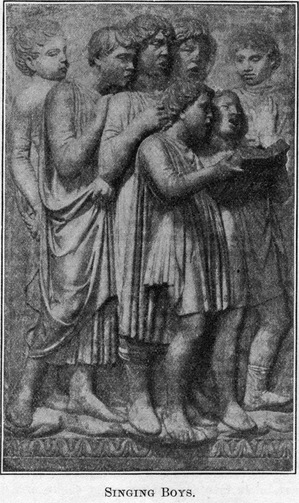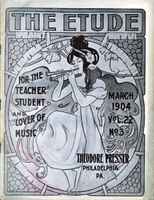BY HORACE P. DIBBLE.
The art of singing and the art of song writing represent to-day, in their respective spheres, their share in the great evolution of the art of music. There are fashions and fads in music as in other things; however, its true growth has not been because of changes in fashion, but a gradual evolution and unfolding in spite of them.
Singing always was, and always will be, unnatural as compared with speech. Unnatural, because in singing we use a certain definite pitch. We also sustain the tone, often for a long duration of time. This duration of time is according to fixed rhythmical pulsations which succeed one another with a certain regularity. In singing we are also compelled to use the voice over a wide range of pitch where it is not used in speech. In all these different ways is singing unnatural as compared with speaking.
While the above always was and always will be true, ancient songs were more unnatural and artificial than are modern songs. There has been a gradual change in modern music toward naturalness or freedom from artificiality. It is the object of this article to contrast songs of one or two hundred years ago with those of recent years.
 While much meritorious poetry was written in the past, a large proportion which was set to music shows artificiality of thought and mood. In fact, that was the age of unreality. Dress, actions, speech, and manners in the educated classes all had this tinge. This was equally true of instrumental music.
While much meritorious poetry was written in the past, a large proportion which was set to music shows artificiality of thought and mood. In fact, that was the age of unreality. Dress, actions, speech, and manners in the educated classes all had this tinge. This was equally true of instrumental music.When we say that the words and music of modern songs are superior in thought and mood to ancient songs, we do not, of course, consider the enormous amount of rubbish and trash which is printed under the head of “popular songs.” In considering the subject of “Ancient and Modern Songs” we refer to the best of each.
While this difference and gradual change from artificiality to reality exists, there seems to be a still greater difference—greater in its demands upon the singer; viz., that of intensity. The words mean more, and the music, in forcibly portraying all that the words suggest, causes demands upon the singer which are much greater than are the demands made by ancient songs.
Ancient songs were, as a class, flowing in their style. They were often filled with runs, turns, trills, and other musical embellishments; in this respect they were musically quite difficult. Such music required long study before it could be executed correctly. Singers were compelled to sing with free throats and use plenty of breath, because this music could not be sung in any other way. The long and arduous practice required to sing such music was sufficient to develop voices to their utmost limit of quality and power.
The so-called “Old Italian Method” of singing was not so much a method of tone production, per se, as it was the long studying of difficult music and the gradual development of the voice by using it freely with correctly controlled breath.
While this music was difficult from a technically musical standpoint, it made but slight demand upon the emotion and mentality of the singer. So long as he was able to deliver a physically large, free, and flowing tone he was apt to be satisfied and expect his public to be satisfied with that tone.
Ancient songs, therefore, had the necessary qualifications for the free development of the voice, and the contrast with the mechanical musical instruments of those days caused the voice to seem more beautiful and powerful than it would have seemed if contrasted with a modern grand piano or a modern orchestra. Modern musical instruments have probably not yet reached the limit of quality and power, but there is always a limit to the human voice. Though we can only judge by what we read, it is probable that the best of the ancient singers attained this limit, and having so attained it had an immense advantage in this respect over the modern singer.
Many modern songs, while requiring an intensity of impassioned delivery, are musically easy—any tyro with an ear for carrying a tune, can learn to sing them after a few repetitions. The consequence is that the young singer attempts such music with an undeveloped voice. If he is gifted with temperament, he feels all the force of words and music, but attempts to express himself with an inadequate instrument. Many a modern singing teacher encourages such attempts and acts as foolishly as would a teacher of piano who would give a Beethoven sonata or a Liszt rhapsody to a beginner.
The accompaniments of most modern songs are much more complex and involved than are those of ancient songs, and their being played on modern instruments makes the contrast of power between singer and instrument all the worse for the singer.
Let us contrast a few favorite ancient songs with those of to-day:—
“Drink to Me Only With Thine Eyes” - Old English
“I Attempt from Love’s Sickness to Fly” - Purcell
“Nina” - Pergolese
“Should He Upbraid” - Bishop
“Caro Mio Ben” - Giordani
“The Lass with the Delicate Air” - Arne
“When the Bloom is on the Rye” - Bishop
“My Mother Bids Me Bind My Hair - Haydn
“Nymphs and Shepherds” - Purcell
“Amaryllis” - Caccini
“La Charmante Marguerite” - Old French
“My Love’s an Arbutus” - Old Irish
You will notice in all of these songs: First, a simplicity, I might say a paucity, in the accompaniment; second, while the voice part is melodious, the music requires in scarcely any portion of it anything like the intensity of passion and dramatic delivery that the majority of the best modern songs need.
Let us compare these with some modern songs taken at random, though purposely selected because they have been and are much sung by amateurs and those with voices unequal to the task of producing the intensity needed for their proper rendition:—
“The Rosary” - Nevin
“My Desire” - Nevin
“A Dream” - Bartlett
“Crossing the Bar” - Buck
“Lost Chord” - Sullivan
“When Love is Gone” - Hawley
“Love is a Bubble” - Allitsen
“At Parting” - Rogers
“Der Asra” - Rubinstein
“What the Chimney Sang” - Griswold
None of these songs are musically difficult, and some of them are quite easy, but they all call for a large variety of emotional expression, and most of them cannot be properly sung without a mastery of breath control.
What are teachers to do to overcome this difficulty? First, we must impress upon each pupil that it is not easy to learn to be a good singer. We should explain that it will take him just as long to be an artist in singing as it will to become an artist in piano playing. Most persons do not believe this.
Second, we should have a regular graded system of study, not merely of technical exercises and vocalizes, but of songs. Many a teacher uses more or less good judgment in selecting exercises and then starts his pupil on an operatic selection, or some song for which the pupil is not yet ready.
The great difficulty is in selecting songs of the first and second grades which will have a content in words and music that makes them worth singing. Much time is required for development of breath control, coupled with freedom and power and beauty of tone. If we use songs that are not beyond the pupil’s limitations they will assist him technically and also give him ideas regarding interpretation, which ideas can be applied to more difficult songs as he progresses. If correctly taught, and if the pupil be not required to sing songs beyond his ability, he can, from the beginning, learn to sing without strain. He can be shown that forcefulness at high or low pitches is not in proportion to the effort to make a big tone, but just the reverse. The desire to “arrive” quickly is a common fault in both teacher and pupil. There is nothing which requires greater patience than the teaching of singing.
Many of these ancient songs when properly selected to meet the needs of the pupil can be used in the first grades. They will be found interesting from both a historical and a musical standpoint.
Most modern songs need more development of technic than do ancient songs, as the stress and strain on the voice is greater; but the songs in themselves do not give the preparatory help which can be derived from a careful study of ancient songs.
Singing is not a lost art. Where a hundred years ago there were only a few great singers before the public at one time, to-day there are many. It is not a lost art, but is one in which it has become much more difficult to attain greatness. To be a great singer to-day one needs not only a great voice, but a great brain and a great soul.



